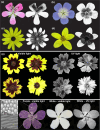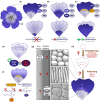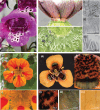Evolution of petal patterning: blooming floral diversity at the microscale
- PMID: 40629857
- PMCID: PMC12371187
- DOI: 10.1111/nph.70370
Evolution of petal patterning: blooming floral diversity at the microscale
Abstract
The flowers of angiosperms are extraordinarily diverse. While most floral variation is visible to the naked eye, this diversity goes beyond the macroscale: Floral organs comprise an underappreciated range of cell types that generate a multitude of patterns across their surfaces and give rise to novel structures. Because diverse cell patterns provide adaptations to biotic and abiotic factors, they also contribute to angiosperm evolution and speciation. Yet, how such diversity originates remains to be understood. In this review, we focus on petals, which together form the corolla, to examine the mechanisms patterning floral surfaces at the cellular level. We summarize current research aiming to understand how cell fate specification and controlled cell growth (proliferation and expansion) are achieved with high spatial resolution during petal development. We also examine the adaptive potential for such patterns and how they contribute to plant fitness and diversification. Finally, we discuss promising directions for future research on the evolution of petal patterning at the microscale and identify outstanding questions that technological advances now make it possible to address.
Keywords: cell type; corolla; evo‐devo; floral development; natural variation; novelty; petal patterning; pollinator attraction.
© 2025 The Author(s). New Phytologist © 2025 New Phytologist Foundation.
Conflict of interest statement
None declared.
Figures






Similar articles
-
Prescription of Controlled Substances: Benefits and Risks.2025 Jul 6. In: StatPearls [Internet]. Treasure Island (FL): StatPearls Publishing; 2025 Jan–. 2025 Jul 6. In: StatPearls [Internet]. Treasure Island (FL): StatPearls Publishing; 2025 Jan–. PMID: 30726003 Free Books & Documents.
-
Beyond the Grant-Stebbins model: floral adaptive landscapes and plant speciation.Ann Bot. 2025 Jul 31:mcaf096. doi: 10.1093/aob/mcaf096. Online ahead of print. Ann Bot. 2025. PMID: 40742017
-
Multifunctionality of angiosperm floral bracts: a review.Biol Rev Camb Philos Soc. 2024 Jun;99(3):1100-1120. doi: 10.1111/brv.13060. Epub 2024 Jan 30. Biol Rev Camb Philos Soc. 2024. PMID: 38291834 Review.
-
Adapting Safety Plans for Autistic Adults with Involvement from the Autism Community.Autism Adulthood. 2025 May 28;7(3):293-302. doi: 10.1089/aut.2023.0124. eCollection 2025 Jun. Autism Adulthood. 2025. PMID: 40539213
-
Under the rainbow: Novel insights on the mechanisms driving the development and evolution of petal pigmentation.Curr Opin Plant Biol. 2025 Aug;86:102743. doi: 10.1016/j.pbi.2025.102743. Epub 2025 Jun 11. Curr Opin Plant Biol. 2025. PMID: 40505365 Review.
References
-
- Abrahamczyk S, Humphreys AM, Trabert F, Droppelmann F, Gleichmann M, Krieger V, Linnartz M, Lozada‐Gobilard S, Rahelivololona ME, Schubert M et al. 2021. Evolution of brood‐site mimicry in Madagascan impatiens (Balsaminaceae). Perspectives in Plant Ecology, Evolution and Systematics 49: 125590.
-
- Amrad A, Moser M, Mandel T, de Vries M, Schuurink RC, Freitas L, Kuhlemeier C. 2016. Gain and loss of floral scent production through changes in structural genes during pollinator‐mediated speciation. Current Biology 26: 3303–3312. - PubMed
Publication types
MeSH terms
Grants and funding
LinkOut - more resources
Full Text Sources

